Abstract
Genes on chromosomes 17q and 18q have been shown to code for putative tumor suppressors. By a combination of allele-loss studies on sporadic ovarian carcinomas and linkage analysis on a breast/ovarian cancer family, we have investigated the involvement of such genes in these diseases. Allele loss occurred in sporadic tumors from both chromosome 17p, in 18/26 (69%) cases, and chromosome 17q, in 15/22 (68%) cases. In the three familial tumors studied, allele loss also occurred on chromosome 17 (in 2/3 cases for 17p markers and in 2/2 cases for a 17q allele). Allele loss on chromosome 18q, at the DCC (deleted in colorectal carcinomas) locus, was not as common (6/16 cases [38%]) in sporadic ovarian tumors but had occurred in all three familial tumors. The results of linkage analysis on the breast/ovarian cancer family suggested linkage between the disease locus and 17q markers, with a maximum lod score of 1.507 obtained with Mfd188 (D17S579) polymorphism at 5% recombination. The maximum lod score for DCC was 0.323 at 0.1% recombination. In this family our results are consistent with a predisposing gene for breast/ovarian cancer being located at chromosome 17q21.
Full text
PDF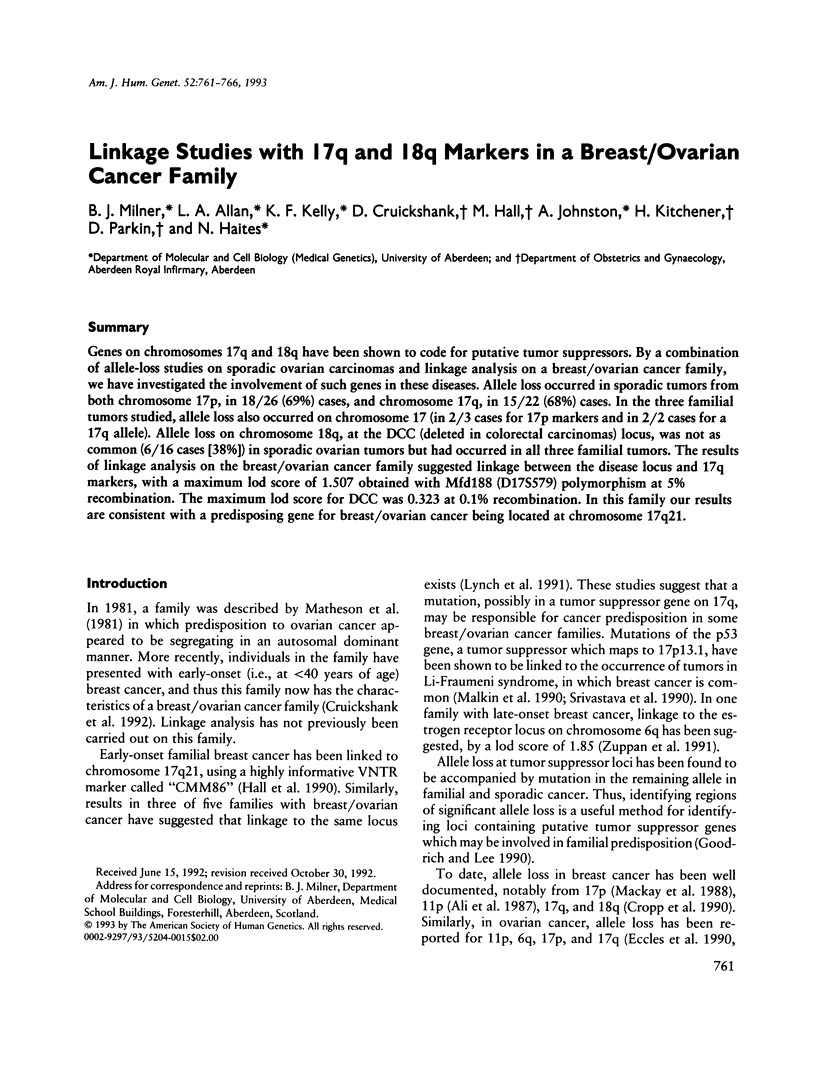

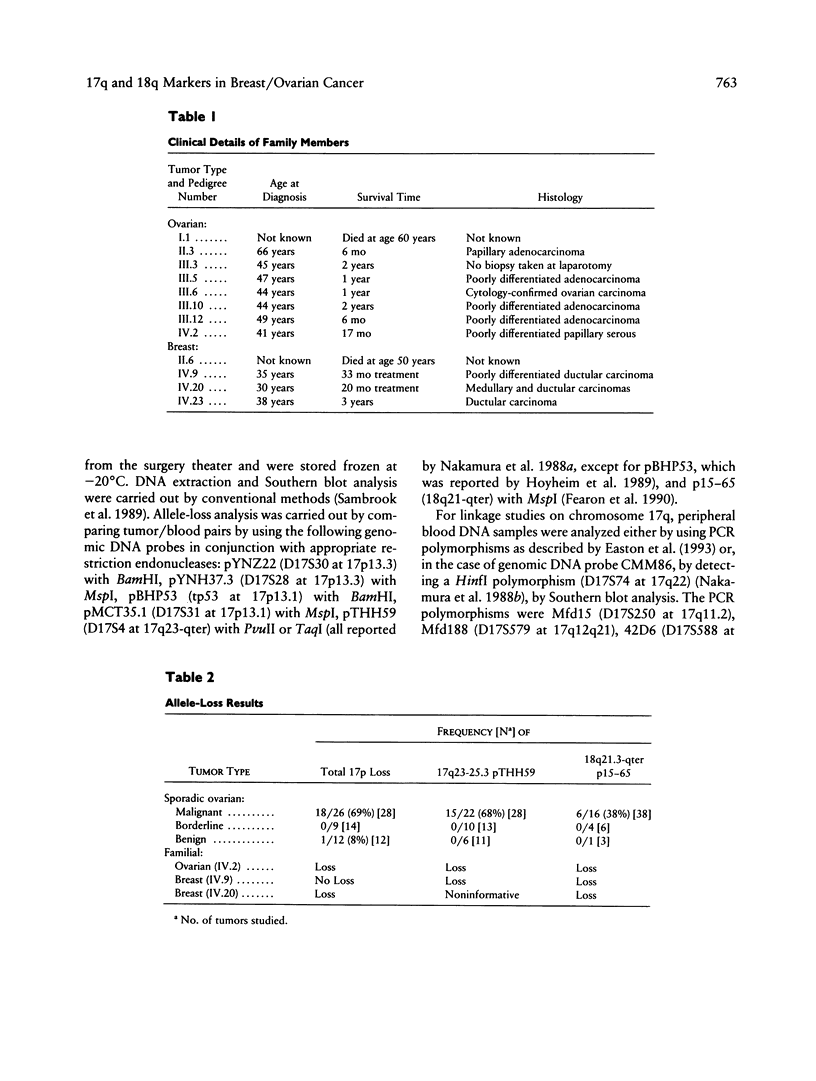
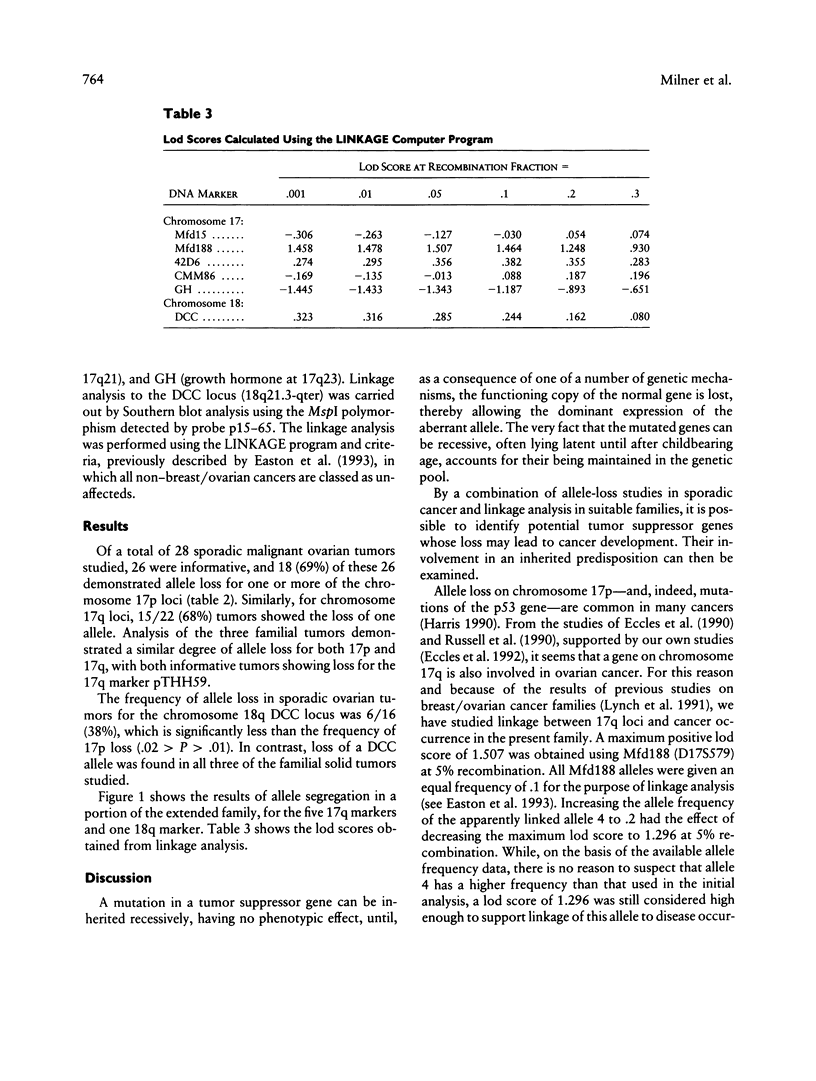
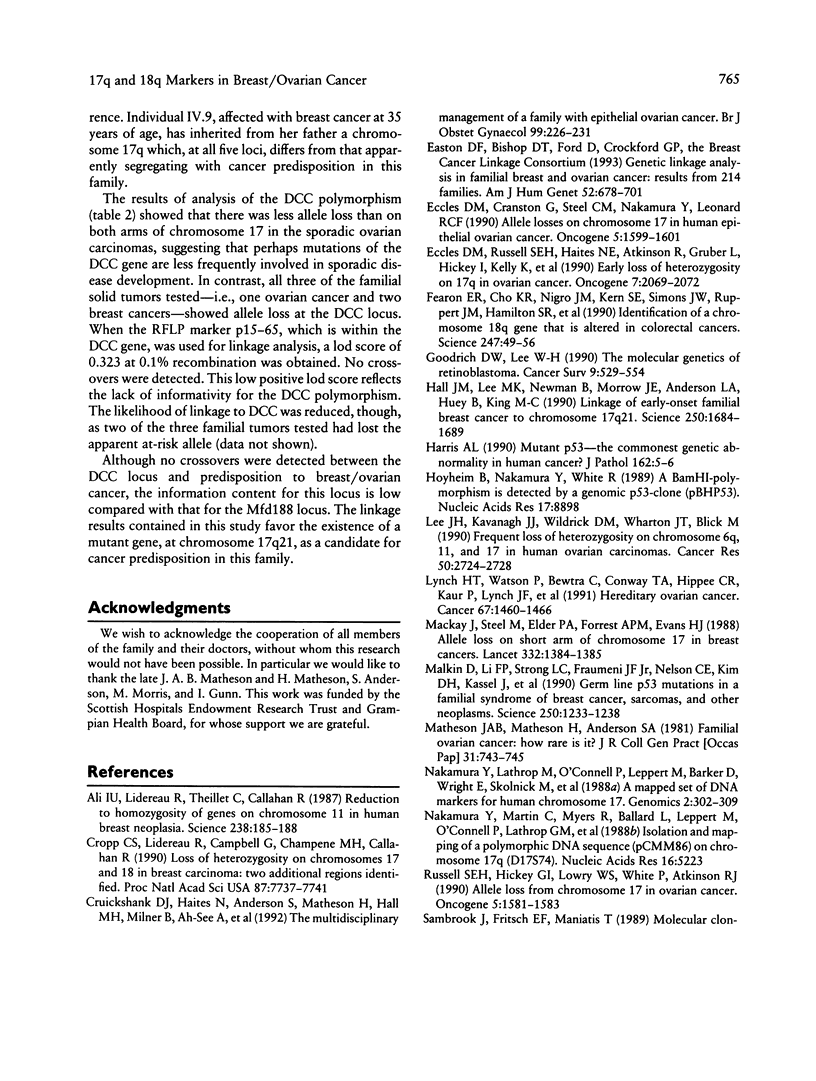
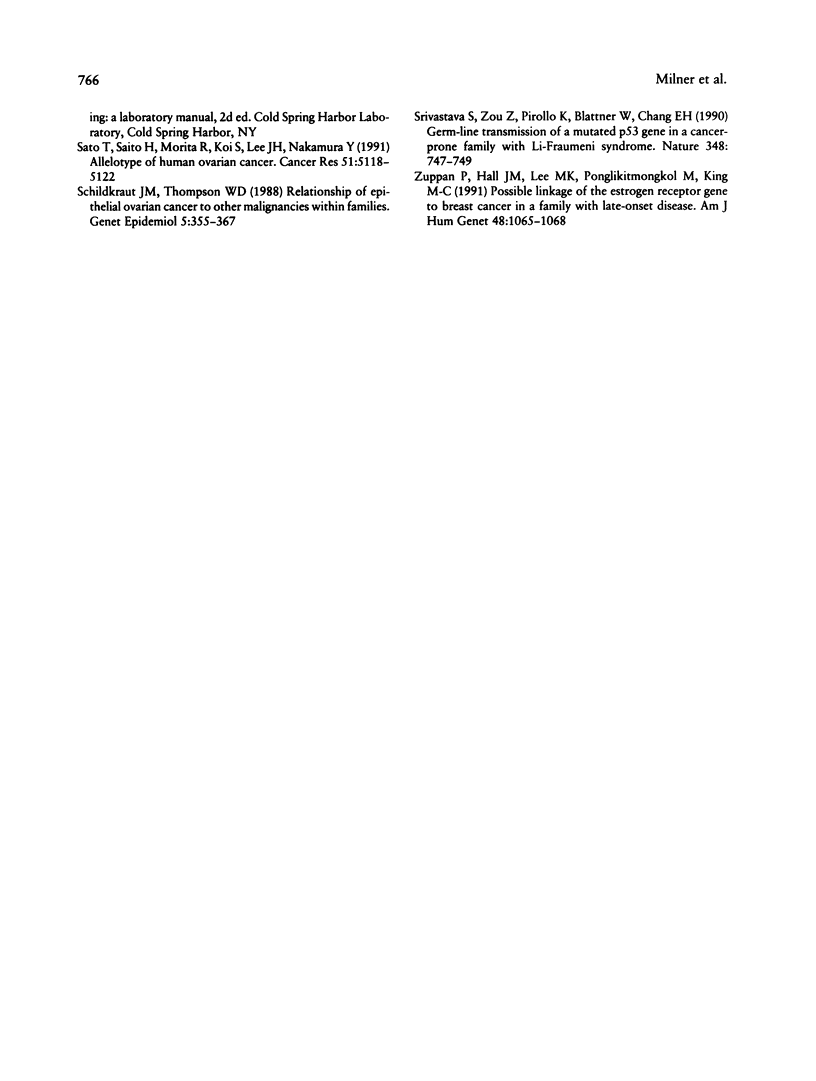
Selected References
These references are in PubMed. This may not be the complete list of references from this article.
- Ali I. U., Lidereau R., Theillet C., Callahan R. Reduction to homozygosity of genes on chromosome 11 in human breast neoplasia. Science. 1987 Oct 9;238(4824):185–188. doi: 10.1126/science.3659909. [DOI] [PubMed] [Google Scholar]
- Cropp C. S., Lidereau R., Campbell G., Champene M. H., Callahan R. Loss of heterozygosity on chromosomes 17 and 18 in breast carcinoma: two additional regions identified. Proc Natl Acad Sci U S A. 1990 Oct;87(19):7737–7741. doi: 10.1073/pnas.87.19.7737. [DOI] [PMC free article] [PubMed] [Google Scholar]
- Cruickshank D. J., Haites N., Anderson S., Matheson H., Hall M. H., Milner B., Ah-See A., Gunn I., Eremin O., Gilbert F. The multidisciplinary management of a family with epithelial ovarian cancer. Br J Obstet Gynaecol. 1992 Mar;99(3):226–231. doi: 10.1111/j.1471-0528.1992.tb14504.x. [DOI] [PubMed] [Google Scholar]
- Easton D. F., Bishop D. T., Ford D., Crockford G. P. Genetic linkage analysis in familial breast and ovarian cancer: results from 214 families. The Breast Cancer Linkage Consortium. Am J Hum Genet. 1993 Apr;52(4):678–701. [PMC free article] [PubMed] [Google Scholar]
- Eccles D. M., Cranston G., Steel C. M., Nakamura Y., Leonard R. C. Allele losses on chromosome 17 in human epithelial ovarian carcinoma. Oncogene. 1990 Oct;5(10):1599–1601. [PubMed] [Google Scholar]
- Eccles D. M., Russell S. E., Haites N. E., Atkinson R., Bell D. W., Gruber L., Hickey I., Kelly K., Kitchener H., Leonard R. Early loss of heterozygosity on 17q in ovarian cancer. The Abe Ovarian Cancer Genetics Group. Oncogene. 1992 Oct;7(10):2069–2072. [PubMed] [Google Scholar]
- Fearon E. R., Cho K. R., Nigro J. M., Kern S. E., Simons J. W., Ruppert J. M., Hamilton S. R., Preisinger A. C., Thomas G., Kinzler K. W. Identification of a chromosome 18q gene that is altered in colorectal cancers. Science. 1990 Jan 5;247(4938):49–56. doi: 10.1126/science.2294591. [DOI] [PubMed] [Google Scholar]
- Goodrich D. W., Lee W. H. The molecular genetics of retinoblastoma. Cancer Surv. 1990;9(3):529–554. [PubMed] [Google Scholar]
- Hall J. M., Lee M. K., Newman B., Morrow J. E., Anderson L. A., Huey B., King M. C. Linkage of early-onset familial breast cancer to chromosome 17q21. Science. 1990 Dec 21;250(4988):1684–1689. doi: 10.1126/science.2270482. [DOI] [PubMed] [Google Scholar]
- Harris A. L. Mutant p53--the commonest genetic abnormality in human cancer? J Pathol. 1990 Sep;162(1):5–6. doi: 10.1002/path.1711620103. [DOI] [PubMed] [Google Scholar]
- Høyheim B., Nakamura Y., White R. A BamHI-polymorphism is detected by a genomic p53-clone (pBHP53). Nucleic Acids Res. 1989 Nov 11;17(21):8898–8898. doi: 10.1093/nar/17.21.8898. [DOI] [PMC free article] [PubMed] [Google Scholar]
- Lee J. H., Kavanagh J. J., Wildrick D. M., Wharton J. T., Blick M. Frequent loss of heterozygosity on chromosomes 6q, 11, and 17 in human ovarian carcinomas. Cancer Res. 1990 May 1;50(9):2724–2728. [PubMed] [Google Scholar]
- Lynch H. T., Watson P., Bewtra C., Conway T. A., Hippee C. R., Kaur P., Lynch J. F., Ponder B. A. Hereditary ovarian cancer. Heterogeneity in age at diagnosis. Cancer. 1991 Mar 1;67(5):1460–1466. doi: 10.1002/1097-0142(19910301)67:5<1460::aid-cncr2820670534>3.0.co;2-s. [DOI] [PubMed] [Google Scholar]
- Mackay J., Steel C. M., Elder P. A., Forrest A. P., Evans H. J. Allele loss on short arm of chromosome 17 in breast cancers. Lancet. 1988 Dec 17;2(8625):1384–1385. doi: 10.1016/s0140-6736(88)90584-3. [DOI] [PubMed] [Google Scholar]
- Malkin D., Li F. P., Strong L. C., Fraumeni J. F., Jr, Nelson C. E., Kim D. H., Kassel J., Gryka M. A., Bischoff F. Z., Tainsky M. A. Germ line p53 mutations in a familial syndrome of breast cancer, sarcomas, and other neoplasms. Science. 1990 Nov 30;250(4985):1233–1238. doi: 10.1126/science.1978757. [DOI] [PubMed] [Google Scholar]
- Matheson J. A., Matheson H., Anderson S. A. Familial ovarian cancer. How rare is it? J R Coll Gen Pract. 1981 Dec;31(233):743–745. [PMC free article] [PubMed] [Google Scholar]
- Nakamura Y., Lathrop M., O'Connell P., Leppert M., Barker D., Wright E., Skolnick M., Kondoleon S., Litt M., Lalouel J. M. A mapped set of DNA markers for human chromosome 17. Genomics. 1988 May;2(4):302–309. doi: 10.1016/0888-7543(88)90018-3. [DOI] [PubMed] [Google Scholar]
- Nakamura Y., Martin C., Myers R., Ballard L., Leppert M., O'Connell P., Lathrop G. M., Lalouel J. M., White R. Isolation and mapping of a polymorphic DNA sequence (pCMM86) on chromosome 17q [D17S74]. Nucleic Acids Res. 1988 Jun 10;16(11):5223–5223. doi: 10.1093/nar/16.11.5223. [DOI] [PMC free article] [PubMed] [Google Scholar]
- Russell S. E., Hickey G. I., Lowry W. S., White P., Atkinson R. J. Allele loss from chromosome 17 in ovarian cancer. Oncogene. 1990 Oct;5(10):1581–1583. [PubMed] [Google Scholar]
- Sato T., Saito H., Morita R., Koi S., Lee J. H., Nakamura Y. Allelotype of human ovarian cancer. Cancer Res. 1991 Oct 1;51(19):5118–5122. [PubMed] [Google Scholar]
- Schildkraut J. M., Thompson W. D. Relationship of epithelial ovarian cancer to other malignancies within families. Genet Epidemiol. 1988;5(5):355–367. doi: 10.1002/gepi.1370050506. [DOI] [PubMed] [Google Scholar]
- Srivastava S., Zou Z. Q., Pirollo K., Blattner W., Chang E. H. Germ-line transmission of a mutated p53 gene in a cancer-prone family with Li-Fraumeni syndrome. Nature. 1990 Dec 20;348(6303):747–749. doi: 10.1038/348747a0. [DOI] [PubMed] [Google Scholar]
- Zuppan P., Hall J. M., Lee M. K., Ponglikitmongkol M., King M. C. Possible linkage of the estrogen receptor gene to breast cancer in a family with late-onset disease. Am J Hum Genet. 1991 Jun;48(6):1065–1068. [PMC free article] [PubMed] [Google Scholar]


